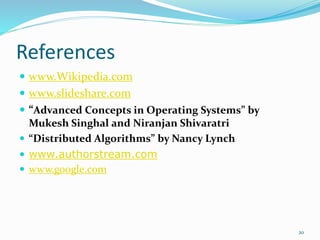Presentation of ditributed system
- 1. Presented by: Nazim Ali En no:GH7764 Faculty no:13BCA141 1
- 2. Outline 1. What is a Distributed System 2. Centralized Vs Distributed Systems 3. Common Characteristics 4. Basic Design Issues 5. Examples of Distributed Systems 6. Advantages and Disadvantages 7. Conclusion 8. References 2
- 3. What is a Distributed System? Definition: A distributed system is one in which components located at networked computers communicate and coordinate their actions only by passing messages. This definition leads to the following characteristics of distributed systems. 3
- 4. Distributed System Characteristics Multiple autonomous components Components are not shared by all users Resources may not be accessible Software runs in concurrent processes on different processors Multiple points of control Multiple points of failure 4
- 5. Centralized Vs Distributed Systems Centralized: Collecting all information at one place allows better decision to be made but is less robust and can put a heavy load on central machine. Distributed: Opposite to Centralized (may also be termed as Decentralized). Here there is no central machine and algorithm is implemented on all the machine. 5
- 6. Common Characteristics What are we trying to achieve when we construct a distributed system? Certain common characteristics can be used to assess distributed systems Heterogeneity Openness Security Failure Handling Concurrency 6
- 7. Heterogeneity Variety and differences in Networks Computer hardware Operating systems Programming languages Implementations by different developers Middleware as software layers to provide a programming abstraction as well as masking the heterogeneity of the underlying networks, hardware, OS, and programming languages (e.g., CORBA). 7
- 8. Openness Openness is concerned with extensions and improvements of distributed systems. Detailed interfaces of components need to be published. New components have to be integrated with existing components. Differences in data representation of interface types on different processors (of different vendors) have to be resolved. 8
- 9. Security In a distributed system, clients send requests to access data managed by servers, resources in the networks: Doctors requesting records from hospitals Users purchase products through electronic commerce Security is required for: Concealing the contents of messages: security and privacy Identifying a remote user or other agent correctly (authentication) 9
- 10. Failure Handling (Fault Tolerance) Hardware, software and networks fail! Distributed systems must maintain availability even at low levels of hardware/software/network reliability. Fault tolerance is achieved by recovery redundancy 10
- 11. Concurrency Components in distributed systems are executed in concurrent processes. Components access and update shared resources (e.g. variables, databases, device drivers). Integrity of the system may be violated if concurrent updates are not coordinated. Lost updates Inconsistent analysis 11
- 12. Basic Design Issues General software engineering principles include rigor and formality, separation of concerns, modularity, abstraction, anticipation of change, … Specific issues for distributed systems: Naming Communication System architecture 12
- 13. Naming A name is resolved when translated into an interpretable form for resource/object reference. Communication identifier (IP address + port number) Name resolution involves several translation steps Design considerations Choice of name space for each resource type Name service to resolve resource names to comm. id. Name services include naming context resolution, hierarchical structure, resource protection 13
- 14. Communication Separated components communicate with sending processes and receiving processes for data transfer and synchronization. Message passing: send and receive primitives synchronous or blocking asynchronous or non-blocking Abstractions defined: channels, sockets, ports. Communication patterns: client-server communication (e.g., RPC, function shipping) and group multicast 14
- 15. 15 System Architecture Client-Server Peer-to-Peer Services provided by multiple servers Proxy servers and caches Mobile code and mobile agents Network computers Thin clients and mobile devices
- 16. Examples of Distributed Systems Local Area Network and Intranet Database Management System Automatic Teller Machine Network Internet 16
- 17. Economic Speed Inherent distribution of applications Reliability Extensibility and Incremental Growth Data integration 17 Advantages of Distributed system
- 18. Disadvantages of Distributed system Complexity Network problem Security 18
- 19. Conclusion Despite the increased complexity and the difficulty of building distributed computing systems, the installation and the use of distributed computing systems are rapidly increasing. This is mainly because the advantages of distributed computing systems overcome their disadvantages. 19
- 20. References www.Wikipedia.com www.slideshare.com “Advanced Concepts in Operating Systems” by Mukesh Singhal and Niranjan Shivaratri “Distributed Algorithms” by Nancy Lynch www.authorstream.com www.google.com 20
- 21. 21





















